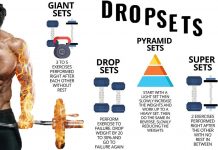🚨 COMPLEX BACK WORKOUT TUTORIAL

🚨 HOW TO Bent-Over Row:
- Holding a barbell with a pronated grip (palms facing down), bend your knees slightly and bring your torso forward, by bending at the waist, while keeping the back straight until it is almost parallel to the floor. Tip: Make sure that you keep the head up. The barbell should hang directly in front of you as your arms hang perpendicular to the floor and your torso. This is your starting position.
- Now, while keeping the torso stationary, breathe out and lift the barbell to you. Keep the elbows close to the body and only use the forearms to hold the weight. At the top contracted position, squeeze the back muscles and hold for a brief pause.
- Then inhale and slowly lower the barbell back to the starting position.
- Repeat for the recommended amount of repetitions.
✅ Caution: This exercise is not recommended for people with back problems. A Low Pulley Row is a better choice for people with back issues.
Also, just like with the bent knee dead-lift, if you have a healthy back, ensure perfect form and never slouch the back forward as this can cause back injury.
Be cautious as well with the weight used; in case of doubt, use less weight rather than more.
✅ Variations: You can perform the same exercise using a supinated (palms facing you) grip.
🚨DEADLIFT MUSCLES WORKOUT!
A deadlift is a compound exercise where a weighted barbell starts on the floor. This is known as “dead weight.” It is lifted with no momentum, giving the exercise its name.

🚨 How many deadlifts should you do?
✅ The number of deadlifts you should do depends on the amount of weight you’re using. If you’re at an advanced fitness level, you’ll need a heavy amount of weight to benefit from deadlifts. If that is the case, perform 1 to 6 deadlifts per set, and perform 3 to 5 sets, resting in between.
✅ If you are new to deadlifts and focusing on getting the correct form down with a lower weight, perform 5 to 8 deadlifts per set. Work your way up to 3 to 5 sets. Remember, correct form is always more important than the number of sets. Perform deadlifts no more than 2 to 3 times per week, allowing muscles ample time to rest in-between workouts.
🚨 How to do a deadlift
- Stand behind the barbell with your feet shoulder-width apart. Your feet should be almost touching the bar.
- Keep your chest lifted and sink back into your hips slightly while keeping a straight back. Bend forward and grip the barbell. Keep one palm facing up and the other facing down, or both hands facing down in an overhand grip.
- As you’re gripping the bar, press feet flat into the floor and sink your hips back.
- Keeping a flat back, push hips forward into a standing position. Finish standing with your legs straight, shoulders back, and knees almost locked out. The bar should be held with straight arms slightly lower than hip height.
- Return to the starting position by keeping the back straight, pushing your hips back, bending the knees, and squatting down until the bar is on the ground.
- Repeat the exercise.
✅ Aim for 1 to 6 reps, depending on the amount of weight you are lifting. Perform 3 to 5 sets.
🚨 LAT PULLDOWN
✅ I see a lot of people sitting straight up when they perform the lat pulldown.

✅ Sitting straight up puts more emphasis on your rear delts and upper back instead of your lats. Instead, have a slight lean, straight upper back, slight curve in the lower back, chest puffed out and pull through the elbows. This will allow you to engage your lats more efficiently!
🚨 BARBELL PULLOVER
✅ If you long for the v-taper that makes your back look wide and strong and your waist skinny, add barbell pullovers to your training arsenal. The exercise trains your latissimus dorsi, the broad muscle that covers the back of your ribs, along with other muscles of the back and the chest to create a strong-looking, thick upper body. The exercise is not popular, but it’s good if your goal is to fill out your midsection while creating optimal function in the shoulders.

🚨 Back Booster
✅ The dumbbell pullover progresses the shoulder through a full range of flexion, the movement of extending the arms overhead. This action uses the lats as well as the rhomboids of the upper back and the posterior deltoids at the back of the shoulders. The move thus creates a wider, more muscular back that’s desired by many bodybuilders and fitness competitors, especially when used to augment a routine that includes lat pulldowns, pullups and rows.
🚨 Complements Presses
✅ You can get a leg-up on gym-goers who use the bench press as their primary, or only, chest builder by adding the barbell pullover to your routine. The pectoralis major and pectoralis minor, the two primary muscles of the chest, activate during every rep of the barbell pullover. The move helps expand your rib cage, explains bodybuilder Lee Hayword on the website “Critical Bench,” and thus makes muscular arms and shoulders look proportional to the rest of your frame.
🚨 Do It Right
✅ You can do the barbell pullover by lying parallel or perpendicular to a workout bench. Lying perpendicular requires more balance finesse and activation of your core muscles to keep you stable. You should be holding the barbell with an overhand grip and position it above your chest — arms extended with just a slight bend in the elbows. Use control to lower the bar over head. Your upper arms will be near or even parallel to your ears. Move the bar back to the starting position to complete one repetition. Take care to keep your back and hips from arching as you move your arms overhead. Keep the movement slow and controlled, using light weights when you first begin adding the exercise to your routine so you can perfect form. If you have any shoulder pain, discontinue the exercise — it’s not for you. Aim for one to three working sets of 10 to 15 repetitions. Leave them for near the end of your workout, says Hayward, when your muscles are already warm and ready for an extra pump.

















































